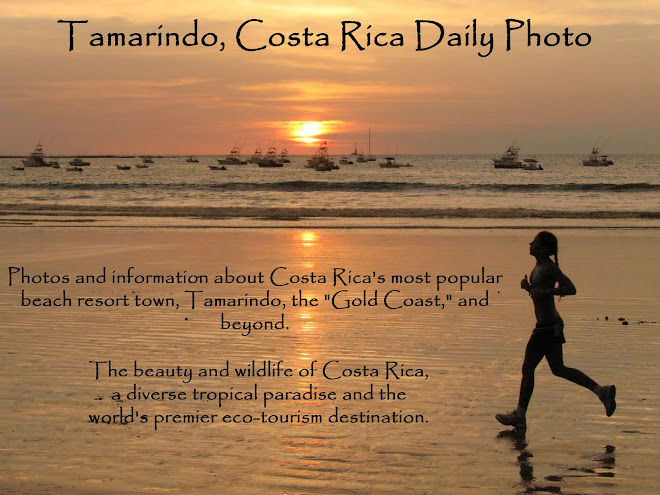+0644+P1010089.jpg)
Tamarindo is very popular for surfing. There are many shops in town that rent surf boards and give surfing lessons. This photo was taken on the main part of Tamarindo beach, which has conditions that are ideal for surfing. The waves break at multiple points, both right on the beach and a little off shore. The water is warm throughout the year.
Playa Langosta, just around the point to the south of Tamarindo, also has good conditions for surfing. There are a lot of good surfing locations, so they are not crowded and surfers and swimmers can stay out of each other’s way.
I have read that Tamarindo was featured in the surfing movie Endless Summer II, but I have never seen the movie. Moreover, anyone who has seen the movie would not recognize Tamarindo today. It is no longer a sleepy Costa Rican beach town where surfers hang out, relatively undiscovered by the modern world.
As future photos will show, Tamarindo has many modern resorts, fine restaurants, and other services and amenities for tourists with a wide variety of interests, not just surfers. Visitors include families with children of all ages, adults interested in golfing, hiking, bird watching and wildlife viewing, zip lines, ATV and off-road trips, river rafting, ocean kayaking, sport fishing, snorkeling and scuba diving, shopping, fine dining, Spanish classes, or simply relaxing at the beach and escaping cold weather up north.
But, despite its development, Tamarindo is still popular for surfers.
 This is a view of the Pacific Ocean at Playa Langosta, from the patio/balcony of our condo. The waves roll in and break at several points, causing a constant sound of the surf. On sunny days, which are most days (especially during the dry season from November until May), the Pacific Ocean takes on a brilliant blue color more typical of the Caribbean or Mediterranean.
This is a view of the Pacific Ocean at Playa Langosta, from the patio/balcony of our condo. The waves roll in and break at several points, causing a constant sound of the surf. On sunny days, which are most days (especially during the dry season from November until May), the Pacific Ocean takes on a brilliant blue color more typical of the Caribbean or Mediterranean. 
+P1090200.jpg)

+P1100095.jpg)




+IMG_1187.jpg)
+P1100078.jpg)





.JPG)





+0644+P1010089.jpg) Tamarindo is very popular for surfing. There are many shops in town that rent surf boards and give surfing lessons. This photo was taken on the main part of Tamarindo beach, which has conditions that are ideal for surfing. The waves break at multiple points, both right on the beach and a little off shore. The water is warm throughout the year.
Tamarindo is very popular for surfing. There are many shops in town that rent surf boards and give surfing lessons. This photo was taken on the main part of Tamarindo beach, which has conditions that are ideal for surfing. The waves break at multiple points, both right on the beach and a little off shore. The water is warm throughout the year.+0530+P1000781.jpg)